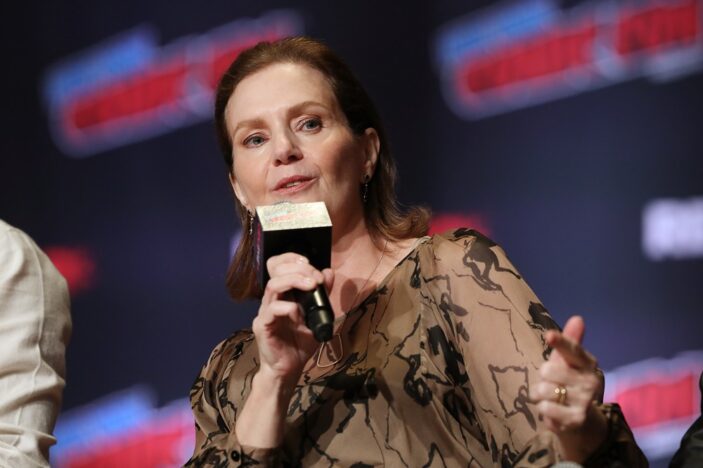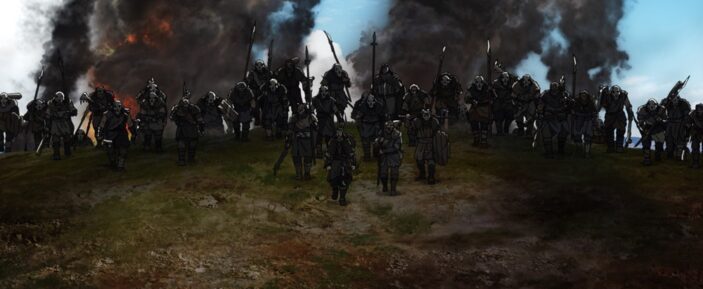
The original anime feature The Lord of the Rings: The War of the Rohirrim returns audiences to the epic world brought to life in The Lord of the Rings Trilogy, based on the revered books by J.R.R. Tolkien.
Set 183 years before the events chronicled in the original trilogy of films, The Lord of the Rings: The War of the Rohirrim tells the fate of the House of Helm Hammerhand, the legendary King of Rohan. A sudden attack by Wulf, a clever and ruthless Dunlending lord seeking vengeance for the death of his father, forces Helm and his people to make a daring last stand in the ancient stronghold of the Hornburg—a mighty fortress that will later come to be known as Helm’s Deep. Finding herself in an increasingly desperate situation, Héra, the daughter of Helm, must summon the will to lead the resistance against a deadly enemy intent on their total destruction.
A vision from acclaimed award-winning filmmaker Kenji Kamiyama, helping bringing this epic tale to fruition is producer extraordinaire Philippa Boyens, who has a long history with Middle Earth, having produced the original trilogy and The Hobbit series.
As The War of the Rohirrim charges into Australian theatres this week (you can read our review here), Peter Gray spoke with Boyens about the challenges and rewards of telling this story in an animated fashion over live-action, and finding the balance in staying faithful to Tolkien whilst forging an original story.
Obviously in talking about The Lord of the Rings we’re going into massive lore, but did you find there were any particular challenges, or even rewards, in telling this story through animation over live-action?
I actually learned a lot on the process of doing this. I didn’t have a huge understanding of how anime was made. I was blissfully ignorant. I remember when I first pitched the story to Kenji Kamiyama, I was telling him about some of my thoughts, and they were nodding and getting it. It was him and Joseph Chou, one of our producers, and I burst into this whole kind of enthusiastic thought about what we could do, and because it’s animation we can do this charge of 3000 horses clashing together! They went deadly silent. And then Joseph asked, “How many horses?”
What I began to learn is every single one of those horses needs to be hand drawn. And every movement that the horse makes needs to be hand drawn in anime. However, we have our magnificent charge, and those guys did it. In terms of challenges, with animation you really need to commit to the story. You’re not getting reshoots. You’re not getting do-overs. You really need to be working with a director who understands the wholeness of the story, if you know what I mean. The pace that the story needs to move at, (and) how he’s going to move the pieces of the story, and that’s what we had with Kenji Kamiyama, who I think is a phenomenal talent. One of the things that I’m most excited about is that, you know, he’s hugely famous in Japan, (but) I really hope that Western audiences are just going to learn how brilliant this guy is.
Anime seems to have a nice crossover with general audiences, and I think Lord of the Rings tying into that means it’s a nice merge for everybody. The animation in this is stunning! You being such a key figure in bringing Middle Earth projects to life, how do you approach balancing fidelity to Tolkien’s vision and then introducing new characters to the world?
You know, that’s one of the good things, I think, that I could bring to the film, is that experience of having done this before. I’m a huge Tolkien fan, not an expert, just a fan, but what I have learned from working with Fran (Walsh) and Peter (Jackson), especially, is at some point you have to set that aside, because you’ve got to make a great movie. Telling a story has its own requirements. It has its own needs and demands of it. So what we tend to do is we look at how is this going to work on film? What’s missing? What do we need to create? And in some ways, in that process, we go further and further and further away from the original text. But at some point, what we try to do is then pull ourselves back and find that authenticity, so that it is genuinely reflecting the world that Professor Tolkien created.

You know what it is to go big with these films, and I love that you just went for it. That’s one of the things I loved about this film, is that it’s so expansive, yet feels so intimate at the same time. It’s the perfect blend of Western audience mentality and this beautiful anime. I really can’t say enough about how beautiful this film is.
Oh, you’re welcome. And you know what? I really hope that it brings that new audience to the world, but also brings a new audience to anime, actually. I think there’s some older folks out there who probably are really skeptical about watching an anime film, and I challenge them to do and watch this, because I think they’re going to be really surprised. It’s an art from. It’s a genuine art form.
And this is the first time something like this has been attempted. I think the audacious talent of Kenji Kamiyama to do this and to commit to making a Lord of the Rings film in this really interesting, fresh attack on anime is fantastic.
The Lord of the Rings: The War of the Rohirrim is screening in Australian theatres from December 12th, 2024.
